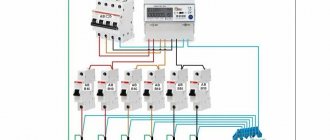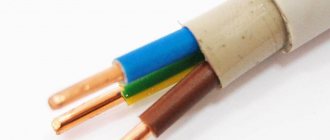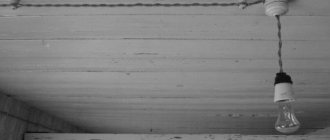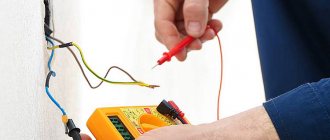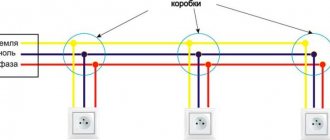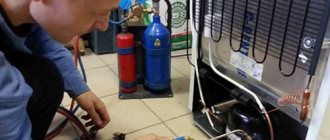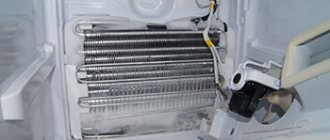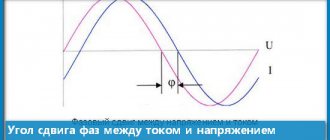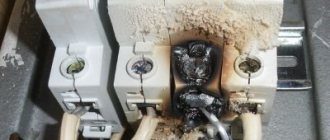The cable is heating up: causes of heating, solutions
Heating of power wires is a common cause of fires not only in production, but also in apartments.
The high temperature of the conductor leads to melted insulation, and as a result, to an open source of fire. If you notice that the cable is heating up, then the cause of its heating should be eliminated immediately.
This article will help in determining such a reason and bringing a household appliance to the appropriate level of electrical safety.
The main reasons for heating cables and wires
To understand the reason for the heating of electrical wiring, you need to remember the basics of electrical engineering. Electric current is the ordered movement of free electrons, in the path of which other atoms of a substance appear. A certain number of such atoms is called electrical resistance. If the resistance is too high, the temperature of the material increases.
An example of securely tightened wires
This principle is successfully applied, for example, in water heaters. In other household appliances or the electrical network, it is necessary, on the contrary, to reduce the heating of the conductors - to bring it to the nominal level.
The main reasons for heating cables and wires:
- The reason why the wire heats up is the choice of its wrong cross-section. When choosing a small cross-section of wires, which haunts almost all would-be electricians, and a constant current strength, a rapid increase in the temperature of the cable occurs. The same principle applies to water pipes - the larger the diameter, the greater the water pressure.
- Overheating of the line occurs due to improper installation. For example, a minor short circuit that does not respond to an overrated circuit breaker. The machine does not open the line - the cable continues to heat up, and after a while it burns out.
- Poor quality connection or oxidation of contacts. Aluminum wires oxidize very quickly, the connections of which should be checked more often than copper wires. In order not to worry about the quality of twisting, it is better to use special terminal blocks or carefully solder the cables.
- Using a low quality cable or wire. Now the electrical equipment market is rapidly filling with products from Korea and China, the quality of which leaves much to be desired. Such a cable, even if installed correctly, can itself cause heating and fire.
Solutions to the problem
If you notice a heating cable, then you need to know how to solve this problem. There are several popular ways to determine the problem and fix it.
What if the neutral wire gets hot?
It is a rare case when the neutral wire in the electrical panel begins to heat up. For example, when recently laying a resistive cable for floor heating in an apartment. You should know that there is no life-threatening potential on the neutral conductor, and its temperature should be within room temperature, but not higher.
What could cause this heating?
- With uneven distribution of currents. This means that at the working zero the current strength exceeds the current that passes through the phases. Self-regulating cables, which are used to heat pipes, lead to this result due to their power. In this case, the zero can not only overheat, but also burn out.
- Poor contact of the neutral wire with the neutral bus. Accompanied by an unpleasant crackling sound and sparking. It is enough to tighten the contact or check the nearest place of twisting and the problem will be eliminated.
- Connecting electrical devices that directly affect the frequency. These are: induction furnaces, pulse consumers, heating cables, LED-based lighting sources, etc.
Consequences of poor-quality neutral wire contact
Conclusion
The above malfunctions are often a consequence of one problem - poor contact. Of course, there are other reasons: poor cable quality, inappropriate circuit breaker, old wiring and much more. But the most common is a contact that interferes with the electrical energy passing through the conductor.
To avoid the consequences of excessive heating of the cable, it is necessary to periodically check the connections in electrical panels and distribution boxes, and, as necessary, tighten or tighten the twists or terminal blocks.
Dependence of heat on temperature
Heat and temperature are two very different quantities and should not be confused. Here's a graphic showing this difference:
Heat is the energy that causes an increase in the temperature of an object and its unit is Joule [J]. Why, given the same amount of energy, does a small cup of water heat up more than a larger container? The explanation is simple. The total energy transferred to an object is evenly distributed among all its particles. The more molecules that need to be separated, the less energy is available for each of them. Lower energy of molecules means they reach a lower temperature, the unit of which is Kelvin (K), and in Russia we use degrees Celsius.
Useful tips
When performing repair work on an electrical circuit, it is important to follow a few tips. Let's highlight the main ones:
Let's highlight the main ones:
- Always check the voltage level before carrying out repairs.
- If possible, call a specialist for electrical repairs.
- Install high quality machines. This requirement also applies to wires, sockets and switches.
- For safety, use cotton tape (it provides better insulation).
- The appearance of visual damage or thinning of the metal indicates the need to replace the socket.
Please note that electricity is deadly and should not be trifled with. If any problems arise with the outlet, junction box or input panel, it is better to fix the problem immediately.
Delaying repairs often leads to aggravation of the situation, damage to household appliances and even a fire.
Additionally, working on an electrical circuit without the proper knowledge may result in exposure to voltage, serious internal injury, or death.
Zero break, zero burnout - consequences!
Rating: 5 / 510Zero breakage, zero burnout - consequences!
"What doesn't kill us makes us stronger." Controversial statement.
It definitely cannot be classified as electricity, because the effect of current on the human body depends on a huge number of factors, from body temperature to the presence of diseases.
Of course, no one is immune from being caught under voltage. But you can easily reduce the likelihood of such an incident. In this article we will tell you in detail about the break or burnout of the zero, the consequences of this, and protective measures.
As you know, three power supply circuits for electrical receivers are most widespread: triangle, star and star with zero. The first two are used mainly where the load is distributed evenly across three phases.
Advice
For example, the windings of electric motors or transformers are connected using such circuits. In residential and public buildings I use a “star-zero” connection scheme - a regular star with a neutral wire.
What is the reason for its use?
The fact is that in the residential and public sector the load is single-phase: one apartment (floor or private house) is powered from one phase, the next from the second, another from the third, then in the second circle. Since three phases of voltage are suitable for the input panel, the number of apartments in a house or entrance is a multiple of three.
This is an attempt to achieve uniform loading of the three phases. However, it is impossible to ensure that all apartments turn on and off electrical appliances at the same time. To keep the three-pointed voltage star (left) symmetrical, a neutral conductor is used.
What are the dangers of poor connections and connections?
Poor contact of current-carrying wires when connecting to each other and at the points of connection to devices leads to heating of the contact points. Why do the contacts get hot?
The physics of heating of poorly made contacts is explained by a simple law of two physicists, Joule and Lorentz. Let me remind you:
The heat generated is proportional to the square of the current, the resistance of the conductor and the flow time.
With good contact between two metal wiring elements, the heat generated by the current has a very specific value, which is calculated and taken into account when choosing the cross-section of conductors and the ratings of circuit breakers.
When the contact is broken, at short distances of such a violation, or, more simply put, when the contact is weakened, the resistance begins to increase, more heat is released, and the contacts begin to heat up.
The heating of the contacts further enhances the thermal expansion of the connection points, as a result the contact weakens even more. As a result, the contact resistance tends to almost infinity (air specific resistance 1016), heating increases.
Added to the heating of the contacts is the sparking of the contacts, which is accompanied by a colossal release of heat. As a result, burnout of contacts, burning of installation products, or, as the most dangerous option, a fire in the house.
Why does the phase heat up?
Firstly, this is an excess of the permissible current flowing through the phase conductor for a given conductor cross-section. ... Prolonged flow of current more than permissible leads to heating and overheating. Subsequently, if the protection device does not work, the insulation will melt and a short circuit will occur.
Interesting materials:
Who headed Sberbank? Where to use glass jars? Where can I file a complaint against the bank? Where can I spend Thanks from Sberbank? Where to file a complaint against VTB Bank? Where can I complain about Home Credit Bank? Where to complain about Sberbank insurance? Is it possible to pay for a loan from the Eurasian Bank through Caspian Gold? Is it possible to store Raisins in a glass jar? Can sugar be stored in a glass jar?
The main reasons for heating the wiring cable and power cord of electrical appliances
Heating of the supply wire is an extremely dangerous phenomenon that requires immediate elimination. But before you begin repairs, you need to understand where and why heating occurs. In this article we will look at the main causes of heating and how to eliminate them. So, let's begin.
yandex.ru
Why might the cable or power cord get hot?
So, let's start by defining the main causes of heating. There are several main reasons, namely:
1. The cable or power cord cannot cope with the current load.
2. The wiring was installed incorrectly and this causes heating.
3. Wire connections are not made properly.
4. Unsatisfactory quality of the power cable or cord.
These are the main reasons for cable heating, now let's talk about them in detail, immediately looking at solutions.
How to solve a problem
First, let's look at the case when the power cord of an electrical appliance gets hot.
So, first of all, determine the heating location:
– the area near the power plug gets hot.
– the area near the electrical appliance itself gets warm.
– or the entire power cable heats up.
So, in the first option, there may be two reasons: this is poor contact of the wires inside the plug itself. And the solution is this: disassemble the fork and, if necessary, tighten the bolted connection.
The second reason may be the socket itself: due to intensive use, the sponges of the socket do not securely fix the plug and because of this, heating occurs in this place. The solution is as follows: ideally, change the socket to a high-quality one with special pressure springs. But if this is not possible, then simply use pliers to squeeze the contact jaws
Attention. Work on the socket can only be done after the circuit breaker supplying this line has been turned off and the absence of voltage has been checked using a multimeter (indicator).
Another option for heating an outlet is that its rating does not match the current flowing. Perhaps your outlet is rated for 10 A
, and you connect a powerful electrical appliance to it.
is
only to replace the outlet with a more powerful one, rated for 16 A.
yandex.ruIf your cord is heating up near an electrical appliance, then poor contact is also to blame. To eliminate this, open the housing of the electrical device and tighten the bolted connection on the device itself.
But if your entire power cord is heating up, it means that a careless manufacturer saved money and instead of, for example, installed a wire with a cross-section of 1.5 mm2 with a cross-section of 0.75 mm2. In this case, only a complete replacement of the power cord will help.
Now let's look at the reasons for heating the wiring itself
Let's start with the most banal and common reason. In many houses there is old aluminum wiring and when it was laid it was designed for single loads, but now the electrical loads on the network have become disproportionately greater. And because of this, the wiring begins to overheat. In this case, there is only one way out: a complete replacement of the wiring in the house (apartment).
yandex.ru
It is also a very common scenario when the wire in the distribution panel overheats. The reason for this lies in poor contact or incorrect connection.
For example, if a flexible wire is used, then connecting it to a machine or to a grounding bus without prior crimping is strictly prohibited.
yandex.ru
Heating can also occur in distribution boxes. The reason is the same - poor contact. In order to eliminate this problem, it is necessary to replace the twists with a high-quality connection, for example, crimping with sleeves.
yandex.ruImportant. If copper and aluminum are connected in a distribution box, then such a connection can only be made through special connecting terminal blocks
Also, all work in distribution boxes and panels must be carried out with the voltage removed.
Separately about extension cords
I also want to talk separately about extenders (surge protectors). Many people are mistaken that if there are 4 sockets in an extension cord, then you can plug a load of 16 Amps into each of them,
So, to each socket of such an extension cord you can connect a load designed for
16/4 = 4 A.
And if you are using a drum-type extension cord, then when connecting, for example, welding, be sure to completely unwind the wire from the drum. Since in the wound state, inductance appears in the wire, which additionally heats it up, and this can lead to melting of the insulation.
Prevention of overheating of wires
If the wire heats up, you need to know to eliminate this problem. To avoid an emergency on cable lines, you need to follow certain simple rules:
- To avoid damage to the insulation, you need to choose the correct cross-section. The electrical line must be laid in such a way as to prevent it from being accidentally damaged by any sharp objects during repair work. For this purpose, a diagram of electrical networks is drawn up. In addition, the joints must be reliably protected from moisture.
- The cable must be laid in a special box, or under baseboards. In this case, it can be easily inspected and replaced.
- When laying electrical wiring, it is necessary that the places of soldering and twisting are placed in such a way that they are fully accessible for maintenance or repair. Typically, distribution boxes are used for these purposes.
- The ends must be thoroughly cleaned and then securely insulated. It is at the junctions that points of increased resistance are created, causing overheating.
The wiring in the apartment is heating up
There are several possible reasons for overheating of current-carrying conductors, namely:
- the cross-section of the cable or wire is not able to withstand the load from the connected household appliances;
- The electrical wiring was installed incorrectly, resulting in overheating of the cable line;
- poor quality wire connection;
- poor quality of the cable itself.
Now we will look at instructions for determining the malfunction, and will also tell you what to do if the cable gets hot in one case or another.
Causes and solutions to heating cables
Heating of power wires is a common cause of fires not only in production, but also in apartments. The high temperature of the conductor leads to melted insulation, and as a result, to an open source of fire. If you notice that the cable is heating up, then the cause of its heating should be eliminated immediately. This article will help in determining such a reason and bringing a household appliance to the appropriate level of electrical safety.
Energy loss
The resistance of a wire mainly depends on three factors: material, thickness and length. It's not a problem if the power cord of your household appliance gets a little hot. With a length of several meters, the amount of heat generated is an insignificant waste of energy. But what if the wire is tens of kilometers long? For every degree Celsius, a huge amount of wasted heat is released. For this reason, an important goal in the electrical power industry is to minimize the resistance of power lines, which is not easy. A wire that is too thick will begin to sag under its own weight, and the only reasonable material to use is aluminum. Therefore, the primary means of limiting the heat generated is to increase the voltage to 110,000 volts. Thanks to this, the same power can be transmitted using a small current, which automatically reduces the heating temperature.
Faulty plug
There is no point in delaying repairs - the socket may spark and an unpleasant burning smell will appear. In addition to equipment failure, it is simply dangerous, for example due to the risk of fire or electric shock. It is necessary to limit the use of sockets and plugs, or better yet, stop.
If smoke or other serious signs appear, turn off the electricity. Usually the switch is located in the meter on the distribution panel. You need to hire a specialist or fix it yourself. Work is carried out after a power outage.
If the plug breaks, you can replace it or try to repair it.
How to fix the network connection point
Heating of the device, a burning smell, and the appearance of sparks even under normal load indicate that the device should be disassembled to determine the cause of the malfunction. And then the cause must be eliminated.
Turn off the electricity supplied to the suspicious connection point. This can be done by turning the handle of an old bag, unscrewing the plugs, or using automatic fuses. Check the presence of voltage in the network after disconnection. Use an indicator screwdriver or a work desk lamp. After making sure that the light does not come on, proceed to disassembly. Remove the cover from the device. Loosen the screws of the tabs that secure the operating mechanism in the socket
Carefully remove the interior and wires for further analysis.
When inspecting the device, the following faults are most often found:
- The clamping of the power supply cores that connect the distribution mechanism to the wiring in the room has become loose. This damage is more common with soft aluminum conductors. Their ends should be inspected and crumbled parts should be removed. Remove insulation from about 9 mm of the entire wire. Secure them with clamps and assemble the socket. If the wires are copper, you need to tighten the clamp screws using a screwdriver.
- Deformation of the contact plates located in the device sockets. It is a consequence of plastic melting when the load is exceeded. A socket with such a breakdown must be replaced.
- If the device is a pass-through device (that is, the next one comes from it), then even without the plug on it can heat up. The product should be disassembled and the clamps and plates checked. After correction, assemble and check the quality of work.
Overheating of the neutral conductor - why is it dangerous?
You don’t need to be a specialist to understand the fact that excessive overheating of the neutral conductor can subsequently lead to its burnout, and as a result, cause emergency situations.
So, for example, if in apartment buildings a three-phase power supply network is used (zero is common, and the phases are distributed alternately between apartments), then burning out the neutral conductor will inevitably cause phase imbalance, with the possibility of increasing phase voltages to linear values (380V). Naturally, without additional protection in the form of a voltage relay, household appliances with such power supply parameters will certainly fail.
When using a single-phase supply voltage, if the neutral conductor breaks, a potential will remain on its conductors (through switched-on consumers), which is dangerous to humans.
Q = I^2 Rt
The formula says that the more heat (Q), the higher the value of the current (I), the resistance of the conductor (R) and the time (t) of the current. This discovery was controversial at the time - thermal theory suggested that it must be removed from one object to heat another. And suddenly someone said that the wire generates heat on its own! But soon the world had to come to terms with the fact that Joule's theory of thermal energy was correct. The relationship between friction and heat allowed him to calculate how much higher the temperature of the water at the bottom of a waterfall than at the top, and how much work was required to heat a pound of water one degree Fahrenheit. The number of ways to obtain heat was large, which proved that this is nothing more than a type of energy.
Why are there short circuits in wires and contacts?
The main factor of a short circuit is a breakdown of the insulation of current conductors. Violation of the integrity of the insulating sheath of wires, breakdown of contact resistance in an electrical or electronic circuit - all this causes a short circuit.
The main causes of short circuits include:
- high voltage surge;
- insulation wear;
- mechanical damage;
- penetration of foreign objects;
- lightning strike.
High voltage surge
Voltage fluctuations in the centralized power grid are often observed in remote areas of rural areas; such cases also occur in urban environments.
During a voltage surge that far exceeds the permissible standard, the risk of breakdown of the insulation of wires or electrical circuits increases sharply. A situation is created in which the wiring shorts and a short-term arcing may occur.
Insulation wear
The old dielectric sheath of wires dries out over time and can self-destruct. Failure to replace old wires over decades often leads to short circuits.
Mechanical damage
External mechanical impact on the electrical network leads to damage to the insulating layer of conductors. An example of this would be drilling into walls with hidden wiring. A drill caught between the wires causes a short circuit.
Penetration of foreign objects
Dust and small debris that get inside the housing through the cracks of the ventilation grille of an electrical or electronic device most often provoke the occurrence of a short circuit between the elements of the device. Short circuits are sometimes caused by insects and small rodents.
Lightning strike
Natural electrical discharge “attracts” the electromagnetic field of various electrical equipment. A powerful magnetic circuit can become the target of lightning.
Potential Trigger Causes
Why does it knock out traffic jams? If there is no additional (difavtomat, RCD) protection, then there are only three main reasons, these are:
- short circuit - instantaneous overload;
- exceeding the rated load (long-term);
- malfunction of the device itself.
Short circuit (SC)
The most dangerous consequences can be caused by a short circuit - a sudden and sharp jump in circuit current, which provokes instant heating of the wires. At the same time, the voltage drops, and the result is a wiring burnout or, even worse, a fire. Such an emergency situation can be caused by incorrect switching of equipment, damaged insulation, or water getting into the wiring.
The faster the protective device reacts, the less harm a short circuit will cause. There are incidents that are familiar to many. For example, a short circuit when the light is turned on. It is caused by shorted exposed wires located in the socket; there are often situations when the lamp itself becomes the source of the problem. In this case, a small short circuit occurs inside the bulb, but this phenomenon does not lead to serious consequences: only the lamp fails.
Exceeding rated load
This incident does not end with sad consequences, but the owners themselves are often to blame for the network overvoltage, plugging several devices into one outlet group. The reason is the difference between the starting and operating current: the first is slightly higher than the second.
Powerful units pose a great danger - for example, boilers, washing machines, refrigerators, which provoke a strong current surge in the electrical circuit when starting. To avoid the frequent knocking out of plugs, it is always better to carefully monitor all devices included in a specific outlet group. This applies to both their number and power.
Equipment malfunction
Any plug or machine is a complex device (especially the last one), which sooner or later can simply fail or start working incorrectly, so such options also cannot be ruled out. There is only one solution - buying a new device, a modern one. Another situation - a sudden breakdown of powerful household appliances - leads to the same result - the activation of the protection mechanism.
Reasons without obvious reasons
These are wires in old houses built during the existence of the Soviet Union. At that time, the total power of a small set of household appliances was quite small, so the electrical circuits were not subjected to heavy loads. Such wires are not at all designed for the abundance of devices that now exist in almost every home. In this case, the only way to protect yourself from constantly knocked out plugs is to find and replace potential weak areas.
Excess moisture is another possible culprit for popping plugs. Air has quite a strong electrical resistance. One that is constantly saturated with water vapor loses this property. Therefore, only professional electricians should install sockets in rooms with high humidity - in bathhouses, basements, bathrooms. To install the device there, special structures are required that have a fairly high level of protection from moisture.
Poor terminal connections can also cause automatic protective equipment to trip. To a greater extent, this is caused by soft aluminum conductors. Loose contact inevitably leads to heating of the device. The thermal release (bimetallic plate) reacts to such changes, and the logical result is the activation of the protection. To avoid potential problems, at least an annual inspection of the electrical panel and tightening of the terminals is necessary. If this operation does not help, then you should look for the culprits elsewhere.
Eliminate Heat
Before you begin to troubleshoot any problems associated with electrical appliances, you must first stop the current supply to them. To achieve this, you need to turn off the machine, or unscrew the plugs on the electrical panel, after which the cover is removed from the socket, which is secured with a screw in the central part of its body.
If it is noticeable that the contact wires have been exposed to high temperatures, then this is the reason for the heating of the socket. To bring them back to normal, you need to completely remove the socket from its socket, after loosening the screws that secured it. After this, clean the contacts and place them back into the contact clamps, properly tightening the mounting screws. Then the socket is assembled and installed in its place.
Tags: machine, sconce, view, choice, switch, house, , clamp, replacement, sign, cable, like, , magnet, installation, multimeter, voltage, nominal, skew, potential, principle, wire, manufacturer, , work, relay , repair, socket, switch, row, light, LED, network, connection, wire connection, resistance, ten, type, current, , phase, filter, shield, electricity, electrical panel
